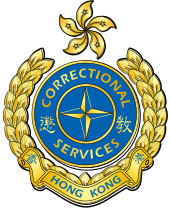Hong Kong Correctional Services
| 懲教署 | |
 |
|
| Agency overview | |
|---|---|
| Formed | 1879 |
| Jurisdiction |
|
| Headquarters | 23rd, 24th and 27th Floors, Wanchai Tower, 12 Harbour Road, Wan Chai |
| Employees | 6,659 |
| Minister responsible | |
| Agency executives |
|
| Website | www.csd.gov.hk/ |
| Hong Kong Correctional Services | |||||||||
| Traditional Chinese | 懲教署 | ||||||||
|---|---|---|---|---|---|---|---|---|---|
|
|||||||||
| Transcriptions | |
|---|---|
| Yue: Cantonese | |
| Yale Romanization | Chìhng gaau chyúh |
| Jyutping | Cing4 gaau3 cyu5 |
Hong Kong Correctional Services (also called Correctional Services Department, CSD, 懲教署) is responsible for prisoners and prisons in Hong Kong. The Commissioner of Correctional Services reports to the Secretary for Security.
Although the Chief Magistrate (now Commissioner of Police (Hong Kong)) was given control over prisons in 1841, the legislation to create the department did not come into being until 1853. CSD was part of the Hong Kong Police Force until 1879 when the role of Superintendent of Victoria Gaol was created. Superintendent of Victoria Gaol was re-titled as Superintendent of Prisons, the department has been financially independent from the Hong Kong Police Force since 1921.
As with all of the Hong Kong Disciplined Services, British-pattern rank insignia continue to be utilised, with the only change being the replacement of the St. Edward's Crown by the Bauhinia flower crest in 1997.
As of 1997 there were four juvenile correctional facilities for males. Female juveniles were held at Tai Tam Gap Correctional Institution, which housed females under age 21. At the time Hei Ling Chau Addiction Treatment Centre and Sha Tsui Detention Centre also held male juveniles.
The current crest of the force was adopted in 1997 to replace most of the colonial symbols:
CSD officers are trained in the use of, and can be issued, revolvers as lethal sidearms, the ASP expendable baton and the Sabre Red pepper spray are the standard less-than-lethal options; additionally a type of pepper gun and the rubber bullet rifle form the standard-issue equipment of the elite anti-riot team officers, known as the Correctional Emergency Response Team (CERT). Aside from handguns officers are also trained in the use of shoulder arms such as shotguns and rifles, however the long arms are rarely issued.
Revolvers are issued to staff escorting prisoners outside the prison, to those stationed in the watchtowers of the maximum security prisons. Other firearms are authorized for use under the observation of senior officers such as when prisoners escape from the prison, riot or when causing damage to the prison.
...
Wikipedia
